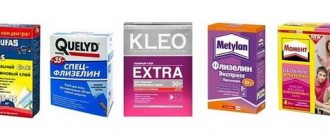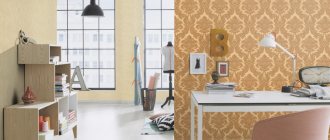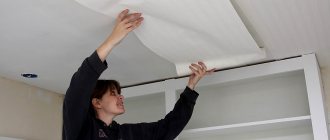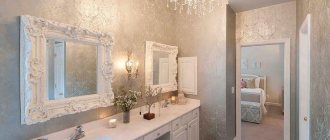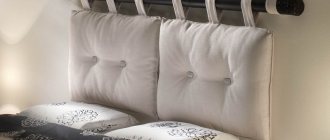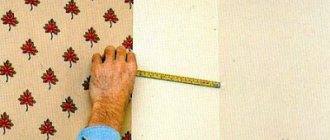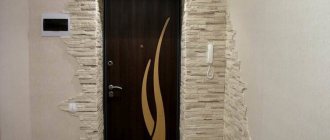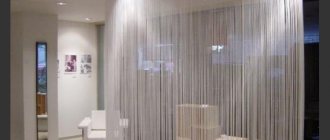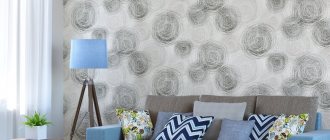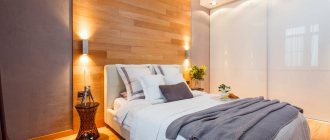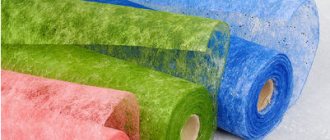Decorative plasters look stylish in the interior of any room. But recently, a lot of wallpaper with imitation of their texture and pattern has appeared on the market. Will they be able to fully replace the plastered surface?
In this article we will compare the technical and operational characteristics of these finishing materials and determine which is better, wallpaper or decorative plaster.
What it is?
Wallpaper with plaster imitates covering a wall with plaster. Color, texture and effects can be different, which allows you to create a completely unusual design. The coating material can have a different composition, is easier to apply than real plaster, and it also has a lower cost.
Compound
The coating, which imitates plaster, has a two-layer structure consisting of a base and a top layer. The main layer is paper or non-woven, the top layer is acrylic, paper (duplex) or PVC. The relief texture for paper and non-woven wallpaper is obtained by embossing; with this manufacturing method, the material is characterized by increased strength and does not stretch when wetted with glue. The relief texture for acrylic canvas is obtained by applying foamed acrylic to the surface; the pattern is applied dotted.
Advantages and disadvantages
Coatings imitating plaster undoubtedly look impressive, but, like any other material, it has its advantages and disadvantages. After considering them, you can decide on the ideal finishing method for yourself.
| Advantages | Flaws |
| Service life up to 15 years. For wallpaper this is a long time, although real plaster lasts longer. | Wallpaper with a paper composition is easily damaged and has a short service life. |
| The surface of wallpaper, unlike plaster, is warm. Suitable for decorating a children's room or bedroom. | Vinyl wallpaper practically does not allow air to pass through. |
| Wallpaper hides unevenness and minor defects in the walls. | Before applying wallpaper, it is necessary to prepare the walls, level and prime them. |
| The cost is relatively low compared to the original plaster. | |
| The material is easy to handle. Wallpaper is applied and removed much easier than real plaster. |
Wallpaper or plaster?
Since wallpaper stylized as plaster and decorative plaster itself are, in fact, interchangeable analogues, the question quite reasonably arises: which cladding is better? When choosing a finish, it is necessary to take into account the purpose of the room for which the cladding is purchased, as well as the specific features of each material.
The service life of a plaster coating reaches 40 years, while for wallpaper this figure is limited to a modest 15 years. However, this advantage of plaster is very dubious, since indoor renovations are carried out much more often, approximately once every 10 years.
The resistance to mechanical damage of cladding based on mineral powders is significantly higher than that of other types of finishing, so for rooms where pets live, it is better to choose decorative plaster. But in children's rooms or bedrooms, wallpaper will look more harmonious.
Removing plaster from walls is not so easy, so this finish is definitely not suitable for those who like to frequently update the design of their home. In this regard, wallpaper fabrics are more mobile, and re-gluing them will not be difficult. In addition, when decorating a room with wallpaper, you can combine several different textured canvases and get a unique panel in your interior, which only a highly qualified specialist could create from a plaster mixture.
Also, do not forget about the cost of each material. With relatively equal costs for purchasing equipment, finishing a room with wallpaper will still cost less than covering it with decorative plaster.
Advantages of wallpaper coverings:
- have an antistatic effect,
- practical texture that can hide the joints of the canvases,
- ease of gluing and dismantling,
- strength,
- resistance to fading,
- improve the sound insulation of the room.
Types and characteristics
Wallpaper for plaster, like any other, can have a different composition. By type they can be divided into non-woven, vinyl, paper and liquid. A variety of types allows you to choose the best option for the room.
Under textured plaster
The canvas has a relief pattern, with noticeable irregularities and roughness. The coating is similar to the original plaster, the images can have different effects, such as plastered stone or chaotic strokes. However, such wallpaper can quickly lose its presentable appearance in places of frequent contact with other objects, such as a hallway or children's room.
Under structural plaster
The canvases focus attention on the structural part, noticeable bulges and relief. Acrylic material is often chosen as structural wallpaper. On such coatings the structure is especially noticeable; the surface of the wall is soft, however, with frequent contact, it can wear off.
This material can be used for painting, thereby updating the design of the room.
Under Venetian plaster
The coating can have different effects: a shiny surface that will shimmer in the light, the effect of a marble wall, otherwise known as Italian marble, or with elements of natural motifs. The material is wear-resistant, does not fade over time and comes in a wide variety of colors and patterns.
Read more about Venetian wallpaper.
Under silk plaster (liquid wallpaper)
The material initially has the form of a powder and is diluted with water. Liquid wallpaper does not have a uniform surface without joints, is easy to apply and, if necessary, you can replace the damaged fragment with a new one. Frequent contact with water may leave a mark. Compared to regular wallpaper, liquid wallpaper does not differ in such variety.
Under old plaster (aged)
Coverings with aged plaster look impressive in a loft interior. There are noticeable cracks on the surface that give the walls a noble antiquity.
The photo shows a living room-kitchen-living room in a loft style. The wall is decorated with wallpaper that resembles old plaster, with noticeable unevenness and a rough texture.
Selection rules
Canvases are selected taking into account several important nuances. Creating a design involves harmoniously and practically implementing ideas to improve the interior. For some, this may seem like a difficult task. Guided by generally accepted well-known advice, it is possible to avoid wrong purchases, and by looking at photographs of ready-made interior solutions, you can decide on the choice of style.
- It is necessary to take into account the climatic conditions of the room, dividing them into dry rooms, wet rooms with temperature changes, rooms with odors and high humidity, and unheated spaces. And when choosing, focus on conditional markings that reveal the properties of the product.
- Products made from paper, non-woven fabric, and glass are suitable for the bedroom and children's room. With a normal level of moisture, paper coverings withstand the operational period perfectly, especially in such rooms it is necessary to ensure favorable circulation of air and moisture, which is what the above materials have.
- For the kitchen they use non-woven, vinyl on non-woven, and acrylic, latex on paper, and glass wallpaper. It is permissible to use paper-based cloths, but avoid direct sources of water, and it is important that the products can be cleaned with wet cleaning.
- Bathroom, balcony and loggia. For bathrooms, non-woven wallpaper and fiberglass sheets are chosen. The microclimate involves temperature fluctuations, high levels of moisture and direct contact with water, and the fabrics must not only have washability, but also must withstand rougher cleaning. Vinyl handles this load best.
- Entrance areas and living rooms are areas of intensive use, so it is important to choose a product that is durable and highly washable. Non-woven wallpaper, as well as vinyl wallpaper with a denser and harder texture, are the best choice. Foamed vinyl is damaged more quickly because it is soft, so it is better to choose a flat variety with a less convex pattern. In the halls, thematic illustrations stand out especially; in the corridor, the appearance of stone, concrete and other cold motifs.
- Room size. If the room has small parameters, choose light shades to possibly visually increase the perception of space. For large areas, any color is suitable, bright and pretentious shades, adding pomp, and here you can experiment to your own taste. The plot illustrations especially stand out in the halls.
- Too bright a color, often a convex relief, sharp transitions in tone, can negatively affect overall visibility, and over time it becomes boring and becomes boring. Imitating fabric or leather, it’s good to highlight accent areas; silk effects look great on a separate wall. Furniture, lighting and layout play an important role, and what will be the accent in your home is up to you.
Also read: DIY decorative plaster; how to make and apply it
With the help of roll coverings, they embody any style, classic, modern, minimalism. Thanks to the wide variety of appearances, there are no stylistic restrictions, harmoniously combining beauty and reliability. Venetian wallpaper creates an atmosphere of antiquity, concrete textures, despite their cold gray color, create a cozy space, the effects of silk, the shine of metal, bronze, gilding and silver look expensive and attractive. Natural motifs imitating a wood structure are repeated by flax, jute, cork or stone plane, onyx, marble, and other decorative stones, matching travertine, such a popular type of plaster. There are many options for creating an image for every taste.
Photos in the interior of the rooms
In the kitchen
Imitating plaster in the kitchen can create a different mood. Depending on the chosen tone and furniture pieces, the design can suit any style. For example, a warm color of decoration and wooden furniture are suitable for classic and country style; a cool tone of wallpaper in combination with wood, metal or plastic will decorate a modern kitchen design.
It would be more appropriate to decorate the dining area with wallpaper, or protect the work area with protective glass. It will help avoid contamination and mechanical damage.
The photo shows a spacious kitchen in a classic style. The walls are decorated with wallpaper for plaster combined with brickwork.
In the corridor
In the corridor it is worth using a material with increased strength, that is, it is better to refuse paper sheets. Due to possible contact with shoes, outerwear and other items, it is better to choose a more practical type of wallpaper, such as vinyl.
Plaster combines well with real and artificial stone or brick. This finishing technique allows you to protect corners and the most vulnerable places.
In the living room
In the hall and living room, plaster can support a modern or classic design. Finishing with plaster-like wallpaper can be done around the entire perimeter or highlight some walls.
The aged surface and noticeable irregularities will fit perfectly into the loft interior, Venetian plaster will emphasize the luxury of classical styles, and textured wallpaper on the accent wall will harmoniously complement the minimalist and high-tech style.
In the bedroom
The decoration in the bedroom can be completely done with wallpaper to match the plaster or combined with coverings with a different image.
The photo shows a stylish loft-style bedroom. The walls are decorated with different materials: wooden beams, brickwork and wallpaper with imitation plaster.
The texture and pattern can be soft and barely noticeable, which is suitable for a calm bedroom design, or pronounced, with noticeable strokes. This type will look good in a modern design.
The photo shows a bedroom in the new classic style. The design is made in gray in its different manifestations.
Is priming the walls necessary?
Is it possible to glue wallpaper onto plaster without a primer? It's possible, but not necessary.
After all, this is a very important technological stage, since the primer enhances the adhesive properties of the plaster.
Wall primer diagram.
Surfaces must be primed twice: before applying putty and before gluing wallpaper. You should not save on it, because this is actually saving on the quality of repairs.
On a primed surface, the glue is distributed in a more uniform layer, and its consumption is less. A primer is especially needed if the walls are old, loose, and the plaster is crumbling. It is not required only on painted surfaces or coated with finishing putties.
The primer should be selected taking into account the room conditions: its humidity, average temperature, surface texture. Is it possible to glue wallpaper to walls primed with heavily diluted wallpaper glue, as is often done? It is possible, but it is still better to use a composition specifically designed for this.
One of the best options is a white primer for Pufas wallpaper. It can even be applied to drywall and painted walls. It dries in about 6-8 hours, but it is better to paste the wallpaper after a day. Primers “Moment”, “Concentrate 1: 7 strengthening”, Knauf Tiefengrund, Ceresit ST 17 have proven themselves well.
Related article: How to process curtain edges yourself
Since they are difficult to wash, you should wear appropriate work clothing. Particular care should be taken to protect your hands and eyes - splashes of primer can cause irritation to the skin and mucous membranes.
The process of applying the primer itself is simple: with a wide brush, roller or spray gun, it is evenly applied to the prepared plaster. There is no need to be afraid of smudges - you just need to carefully spread them over the entire surface of the wall, starting from the top and moving down. Then let the primer dry thoroughly.
Color spectrum
Gray
Gray color is ideal for interior design in loft, minimalism and hi-tech styles. In order to make the room brighter, you can combine a gray tone with a white or milky finish.
It combines well with both cold and warm shades and equally successfully performs the function of the main and secondary tone.
White
White color can expand the boundaries of a room and make it visually larger. In addition, the white tone can be combined with almost any shade, making it an ideal background and a great addition to bright details.
The photo shows a compact bedroom in a modern style. Light wall decoration helps make the room more spacious.
Light walls will look interesting due to various effects, such as imitation Venetian plaster or a structural surface.
Beige
Walls in beige tones will look great in classic and modern interiors. A neutral shade combined with the unusual texture of the wallpaper will make the interior interesting, but quite calm.
Furniture in both light and dark shades is suitable to fill the room.
The photo shows a dining room in a classic style. The walls are decorated with wallpaper imitating Venetian plaster. Places of frequent contact with chairs are protected by white moldings.
Gold
Walls with a golden tint will fill the house with luxury. For a harmonious balance, it is worth using the golden color in doses, without overdoing it with its quantity.
The photo shows an Asian-style interior. The wall is covered with wallpaper imitating slabs covered with plaster.
Gold will look especially good in Venetian plaster. It is worth remembering that too saturated and bright the color of the walls visually hides the area of the room. It, in contrast with a lighter shade, will help to adjust the boundaries of the room, bringing the desired wall closer.
Presentation in different styles
Loft
Wallpaper with plaster will be one of the best interior solutions for decorating a room in a loft style. The cracked texture with noticeable cracks in the dried plaster fully corresponds to the features of the stylistic direction.
The color scheme can be either in a dark palette or in light colors, depending on the area of the room. Wallpaper with an aged effect, careless strokes and noticeable roughness will look good in a loft interior.
Provence
Gentle Provence is characterized by the use of plastered white walls. Imitation wallpaper will be an excellent analogue, it will help save repair time and money spent on it.
The design will be complemented by stylized wooden or forged furniture with scuffs and light textiles.
Classical
A classic interior is characterized by the use of restrained shades in decoration. Milky or beige wall colors will look harmonious with furniture in light and dark colors.
The finishing is made mainly from natural materials. The design of the room will be complemented by pieces of furniture with graceful shapes and several decorative details.
Sea style
Wallpaper with plaster in an interior with a marine theme can be associated with a sandy shore, shiny rocky stones and water surface. The color palette can be white, blue or turquoise.
Details play a major role in nautical design, such as stylized furniture and themed decorative items.
The photo shows a bright room with a marine theme. The walls in the niche are finished in a beautiful turquoise color, like other decorative items.
Scandinavian
The style has a restrained palette in light colors. The walls are most often finished in white or another light shade.
Since patterns and images on the walls are rarely used in Scandinavian design, a coating with an unusual texture will be an excellent solution for adding a “zest” to the room.
Pre-treatment of walls
If you intend to replace old wallpaper with new wallpaper, you must first remove it. Sometimes new stripes are glued onto old ones. You can’t do this - sooner or later they will start peeling off the walls!
Removing ordinary paper wallpaper is very simple: first moisten it with water (it’s most convenient to use a spray bottle), and then, when it gets wet, clean it off with a spatula. Remains of old wallpaper and unevenness can be easily removed with coarse sandpaper.
Necessary tools for wallpapering.
Walls freed from old wallpaper should be washed with water and allowed to dry. Then you should carry out an “inspection” of the surfaces for roughness and cracks. They will have to be eliminated. If the walls are plastered carefully, you can only cover up light cracks with putty. Nails and screws should be pulled out or their heads should be sunk deeply, and the resulting holes should also be covered with putty.
If the walls are uneven, then covering up the cracks alone will not do - you will have to level them with starting putty. Especially if you are going to stick not ordinary paper wallpaper, but natural or fabric wallpaper, which requires a perfectly flat surface.
Related article: DIY shoe stand
It happens that the walls are lined with dry plaster in the form of sheets of plasterboard. It is necessary to putty all the joints that always exist between them with a plaster solution. When the first layer has dried, pieces of gauze are glued to the joints and puttyed again. Then they level the treated areas with fine sandpaper, ensuring that the entire wall looks like a single whole. Before gluing wallpaper onto gypsum plaster, you should apply a waterproofing coating to it.
It is highly advisable to preventively protect walls from mold fungi by treating them with one of the effective antiseptics. These are, for example, “Xiolat”, “Natura Antimantar”, “Titan Fungicide”, “S-Hydrotex-P”, “Mugel”. The thin film formed after applying the solution reliably protects the wallpaper from mold microorganisms.
Rules for choosing wallpaper for decorative plaster
Before choosing and purchasing a material, you should take into account the characteristics of the room and think about the desired result. By comparing all the nuances you can get a room that is harmonious in all respects.
- Embossed wallpaper is best used in places where external contact with it is minimized;
- When choosing a material, you should take into account their desired service life, since paper sheets will last about years, fiberglass-based coatings will last up to 30 years;
- Color and pattern can visually change the area of a room. Dark colors and large patterns make the room smaller; light colors and small patterns, on the contrary, expand the boundaries;
- Plastered wallpaper goes well with other finishing materials, such as brickwork, stone or other wallpaper;
- Given the wide variety of colors and textures, before choosing, you should take into account the stylistic features of the interior. For example, Venetian plaster will look inappropriate in a Scandinavian style, and an imitation of a roughly plastered wall will not be suitable for a classic design.
Photo gallery
Wallpaper with plaster cannot be called a non-standard interior solution. But it will definitely be a good choice for creating a comfortable and stylish design. A variety of textures and effects allow you to choose the ideal option for the desired style in the interior.
In addition, companion wallpaper will look good with plaster, that is, a coating with the opposite style, color or three-dimensional pattern. Below are photo examples of the use of wallpaper under plaster in rooms for various functional purposes.
